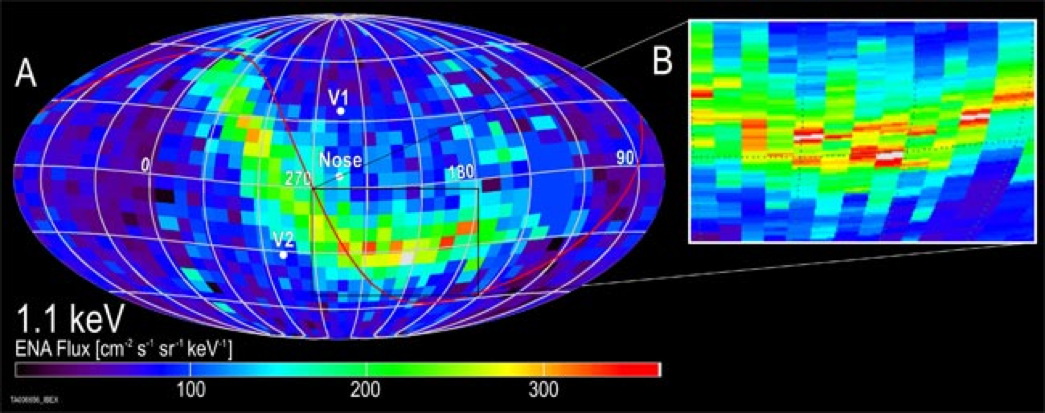Mystery Emissions Spotted at Edge of Solar System

This story was updated at 3:06 p.m. EDT.
In the murky boundary between our solar system and the restof the galaxy, scientists have spotted a bright band of surprising high-energyemissions.
The results come from the first all-sky map created byNASA's new InterstellarBoundary Explorer (IBEX) spacecraft, which launched in October 2008. Whileorbiting Earth, IBEX monitors incoming neutral atoms that originate billions ofmiles away at the solar system's edge to learn about the interaction betweenthe sun and the cold expanse of space.
"The IBEX results are truly remarkable, with emissionsnot resembling any of the current theories or models of this never-before-seenregion," said David McComas, IBEX principal investigator at the SouthwestResearch Institute in Texas. "We expected to see small, gradual spatialvariations at the interstellar boundary, some 10 billion miles away. However,IBEX is showing us a very narrow ribbon that is two to three times brighterthan anything else in the sky."
This ribbon of energy lies at the very edge of the solarsystem, where the bubble of charged particles streaming from the sun finally petersout. This bubble is called the heliosphere, and it encompasses the region ofspace dominated by the sun's influence.
The edge of the solar system
At the boundary of the heliosphere, the sun'spositively-charged particles interact with neutral atoms drifting in frominterstellar space. When these particles meet, an electron may hop over from a neutralatom to a charged one, called an ion. The result: the charged particle becomesneutral. IBEX detects these fast-moving neutral particles and traces their pathsback to the solarsystem's edge to create a picture of this chaotic frontier.
Breaking space news, the latest updates on rocket launches, skywatching events and more!
"We're just now getting a handle on the interaction ofthe surrounding interstellar medium with the heliosphere, and that's providingus with the big picture," said mission co-investigator Eberhard M?bius ofthe University of New Hampshire.
The mission scientists said they were surprised to discoverthe striking band in IBEX's sky maps, because no models had predicted such apattern beforehand.
McComas said when he first saw the IBEX results he thought,"'Something's wrong,' It was quite a long time before we convinced ourselvesthat we were right," he said.
The bright ribbon appears to be shaped by the direction ofthe interstellar magnetic field outside the heliosphere. Scientists think thissuggests that the galactic environment just outside the solar system has farmore influence on the structure of the heliosphere than previously believed.
"[The ribbon is] aligned by and dominated by theexternal magnetic field," McComas said in a briefing Thursday. "That'sa huge clue as to what's going on. But still we're missing some really fundamentalaspect of the interaction - some fundamental physics is missing from our understanding."
The boundary of the solar system was first explored by the Voyager1 spacecraft in 2004 when it encountered an invisible shock created as thecharged particles streamingoff the sun hit the neutral gas from interstellar space. Its sister craft Voyager2 followed into the solar system's edge in 2007. While these spacecraft beganthe exploration of this wild frontier, IBEX is now revealing a whole newpicture.
"The most astounding feature in the IBEX sky maps ? thebright narrow ribbon ? snakes through the sky between the Voyager spacecraft,where it remained completely undetected until now," McComas said.
The new IBEX results will be published in the Oct. 16 issueof the journal Science.
- Video - NASA?s IBEX: Exploring the Solar System?s Edge
- Images - Voyager's Photo Legacy
- Top 10 Voyager Facts

Clara Moskowitz is a science and space writer who joined the Space.com team in 2008 and served as Assistant Managing Editor from 2011 to 2013. Clara has a bachelor's degree in astronomy and physics from Wesleyan University, and a graduate certificate in science writing from the University of California, Santa Cruz. She covers everything from astronomy to human spaceflight and once aced a NASTAR suborbital spaceflight training program for space missions. Clara is currently Associate Editor of Scientific American. To see her latest project is, follow Clara on Twitter.
